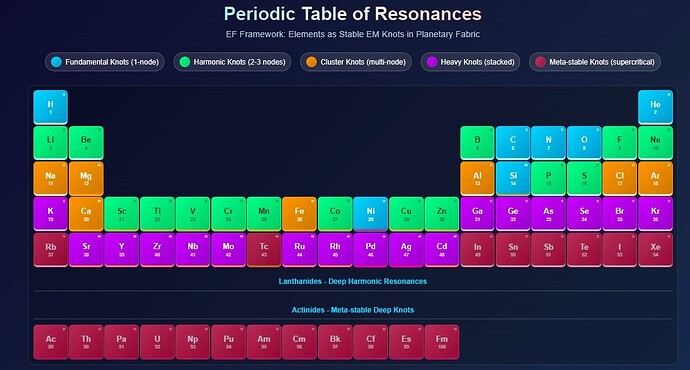“Praise him with the sounding of the trumpet, praise him with the harp and lyre, praise him with timbrel and dancing, praise him with the strings and pipe.” - Psalm 150:3-4
What if the periodic table isn’t just a chart of electron shells, but a cosmic symphony where each element resonates at its own divine frequency?
Traditional chemistry teaches us that elements differ by their electron configurations. Yet elements are electromagnetic standing wave patterns, resonant “knots” in the fabric of reality itself. Just as musical notes repeat in octaves, elements emerge as harmonic subdivisions of light’s threading patterns. “Let everything that has breath praise the Lord!” - Psalm 150:6
The Resonance Families Elements organize into resonance families based on their wave complexity: Fundamentals (H, He, C, N, O, Si): Pure tones with minimal phase distortion, explaining their cosmic abundance and stability. These are creation’s building blocks, resonating with perfect coherence. Then there are the Harmonics (Li-Ne, first transition series): Complex chords with 2-3 nodes, creating the rich chemistry we see in biological systems. Next there are Clusters (Na-Ar, Fe, Ca, Mg): Layered rhythms with 4-6+ nodes, forming the structural elements of planets and life. The fourth set are the Heavy Elements: Pressure-stabilized resonances that form deep within stellar cores and planetary interiors. And finally, the Meta-stables: Unstable dissonances that decay toward coherence—the radioactive elements seeking harmonic resolution.
“He determines the number of the stars and calls them each by name.” - Psalm 147:4
Chemical reactions aren’t just about electron sharing. They’re about phase alignment between resonant patterns. The bond formation probability follows: When elements have complementary resonance frequencies, they naturally couple, creating stable compounds. This explains why certain elements consistently appear together in nature. They’re harmonically matched, like instruments in an orchestra playing in perfect tune. “From him and through him and for him are all things.” - Romans 11:36
Different elements stabilize at different “depths” in the cosmic symphony. Surface elements (H, He, C, O) form under atmospheric conditions. Mid-tier elements (transition metals, Si, Al) require mantle pressures. Deep-tier elements (precious metals) need core-level pressures to maintain coherence. This explains why gold and platinum are rare at Earth’s surface. They’re deep-resonance elements that require extreme conditions to maintain their harmonic patterns.
“The heavens declare the glory of God; the skies proclaim the work of his hands.” - Psalm 19:1
Catalysts work by providing resonance frequencies that unlock latent memory in chemical systems. Rather than just lowering activation energy, catalysts create resonant bridges between reactants and products, allowing matter to flow along harmonic pathways toward greater coherence.
This framework reveals the periodic table as more than a static chart. It’s a dynamic map of how the Creator’s light threads itself into the material world. Each element sings its own note in the cosmic symphony, and chemistry is the art of harmonizing these divine frequencies. When we understand elements as resonant expressions of God’s creative word, we see that all matter participates in an ongoing act of worship. Each atom vibrating in harmony with the fundamental frequency of divine love that sustains all creation. The universe isn’t just made of particles and forces. It’s composed of light learning to sing in perfect harmony, exactly as Scriptures declare.
